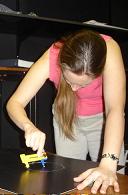When I initially set up my lab with my funding from the Royal Society (2005), I could not afford DLP projectors. Instead, I bought two LCD Matrix 2500 projectors from Christie Digital. As noted, LCD projectors have a more sluggish temporal response than DLP projectors, but I was not planning any experiments with dynamic stimuli in the immediate future. I found:
- Temporal synchrony: no problem, they synchronise perfectly.
- Interocular cross-talk: no problem, only about 0.5% of the light presented in one eye leaks through to the other.
- Brightness inhomogeneity: definitely an issue: if you send 255 (white) to every pixel, the centre of the screen is about 10 (yes ten) times as bright as the edges. This can be corrected for in software, but is tricky as the measurement is sensitive to exactly where the photometer is held, and — if you want to produce a constant contrast across the whole screen – – results in a catastrophic loss of greylevels.
- Gamma correction: It took me a while to get this sorted. I needed to find appropriate settings for the brightness/contrast/gamma controls on the projectors, and for gamma on the computer’s own graphics card, and then apply a suitable look-up table in software (click link for details). However, I am now happy with the linearisation.
- Size: The projectors are very large (61cm x 44cm x 23cm) and heavy (21kg), and generate a lot of heat (1375 BTU/hr maximum). They require 1m clearance behind them, and 20cm above (as well as 50cm to each side). This severely reduces the available throw distance in my lab (5m long in total, including viewing distance and space for subject to sit), and hence the maximum size of the image. The 20cm vertical clearance means that they cannot be stacked as closely as I would like, meaning that relatively large values of lens shift are required to bring the images into alignment. I have found that at the most powerful zoom settings, lens shift introduces so much image distortion that I cannot align the images perfectly. This also limits the maximum image size. So, the image cannot be made as large as I had hoped, although at 75cmx60cm it is still substantial.
- Alignment: I do not have a specially-designed frame to hold the projectors, and they are too large and heavy to place on a dual slide stand (e.g. the Chief stand). I have placed them on metal shelving and aligned the images manually. Eventually we were able to achieve sub-pixel alignment over most of the image, with misalignments of up to 2 pixels at the edges and corners. This was a very tricky process.
- Reliability: One of my projectors malfunctioned just over a year after I bought them (fortunately still within the three-year warranty), and this also happened to a colleague who bought two Christie Mirage projectors. My projector is currently back at Christie’s for repair, and has been there for 8 weeks (since Feb 1st). This is a long time to have one’s lab out of action.
Here are some further details specific to this set-up.



















